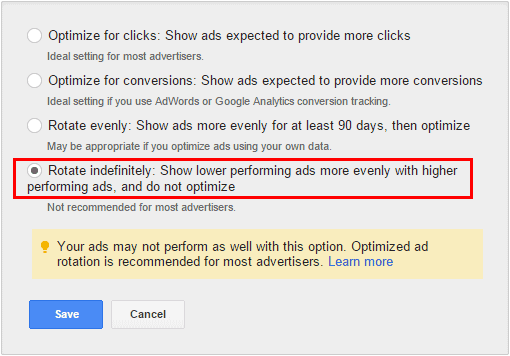It goes without saying that from an AdWords point of view, having a great product, the best keywords, and fine-tuned landing pages is all pointless without good ads.
Poor ads can cost you enormously in the long run. For example, poor ads might receive impressions that have few clicks or even no clicks at all. When this occurs your click-through rate (CTR) will be low if not zero.
Having a low CTR sends Google a signal that your ads aren’t very good and may even be irrelevant. Remember, Google don’t only want to make money off each click, they also want people to find what they’re looking for. If they’re seeing what they want when your ads are displayed, Google will put your competitor’s ads above yours, or may not even show your ads at all.
Poor ads mean that Google will charge you more per click than other advertisers.
Alternatively, if your ads are relevant, it’s more likely that people will click on them. This will in turn produce a higher CTR which will lower how much you pay per click, which is why it’s vital to constantly to write more effective ads.
Begin with a review of your keywords
Think about the person who’s clicking on your ad. How did they get there?
Someone either performed a search using a keyword or they were on a page that was related to one of your keywords.
To effectively communicate what you’re offering, it’s a good idea to separate keywords into distinct themes. Each keyword theme would then become its own ad group. Once you’ve created these ad groups, you’ll be able to make a better connection between the keyword and ad copy.
For example, imagine you’re selling fruit online; apples, oranges, bananas and so on. Potential customers searching for bananas will be more inclined to click on an ad that mentioned “order bananas online” instead of one that mentioned “order fruit online”.
It can also be a good idea to use some of your keywords within your ads. People are more likely to click on your ads if they see the word or phrases that they just searched for.
But before you begin to stuff your ads with keywords, have a look at your competition to see what they are saying within their ads. Remember, each time your ad is displayed, you’re trying to entice the searcher to click on your ad instead of those of your competition.
So your ad needs to stand out.
If most of your competition pack in too many details, try making your ads short and to the point. If all your competitors are using the keyword in the headline, try a different related keyword instead.
And don’t forget to use a call to action. While you can’t use “click here” within your ads, you can use things like learn more, try for free, download now, buy now and so on.
Don’t put all your eggs in one basket
Personally I like to experiment with four ads per ad group that are significantly different from one another, so that I can get a better idea as to what works and doesn’t.
I would also recommend setting the ads to “rotate indefinitely” instead of Google’s options of “optimize for clicks”, “optimize for conversions”, or “rotate evenly.
You can safely ignore Google’s warnings because you’ll want to determine for yourself which ads work and which ones don’t. I always like to be in control instead of giving it up to Google.
While a high CTR will produce a lower cost per click, CTRs should not be your sole metric. You need to also consider what happens after the click.
For example, if you were to have an ad that said “Free HDTVs”, it’s safe to assume that you would receive a large number of clicks resulting in a high CTR. The only problem is that you’re most likely not giving away free HDTVs.
Striking the right balance between ads that produce high CTRs and good results after people land on your website is a good idea.
Creating effective ads is not easy and can be time consuming. If you’ve created one ad and then copied it to all of your ad groups, it’s unlikely to produce your desired results.
Creating multiple ads is vital, and the only way to see what works best. Once you have found a winner, delete what doesn’t work and expand on what does.
Keep on experimenting.
Unique ideas for your business
The Demystifier puts practical ideas into your hands. You won't find them elsewhere. Original, actionable and insanely effective.



